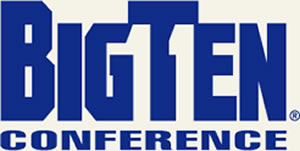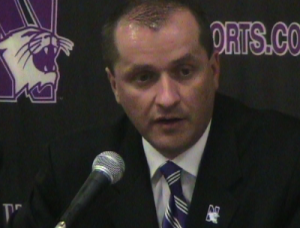There were a lot of topics on the table of discussion in last week’s Big 10 meetings. First and foremost, is the rapid move towards a four team playoff in college football, which could get here in a couple years. I asked Northwestern Athletic Director Jim Phillips what his biggest takeaways were from the meetings.
“Couple things – tremendous collaboration between all 12 institutions in trying to get to the “right place” in current landscape and our complete confidence and trust in Commissioner Delany,” he said.
No doubt about it, Big Ten Commissioner Jim Delany (the second highest paid commissioner, behind only the Pac-12’s Larry Scott) is one of the most powerful men in college football. He’s a big reason we’re getting close to having a true playoff, as his getting on board with the hybrid bowl/playoff idea will be critical to having a final four.
“This is fast approaching but must be done without devaluing the regular season (best in college athletics), reward conference champions, protect the Rose Bowl, and, most importantly, take into account the welfare of our student-athletes (academically and physically),” said Phillips by email.
What the Big Ten wants is to go along with the playoff deal, make a lot of money and yet not have anything change with the Granddaddy of them all. It will be tricky to see how this all works. If you’re a fan of the four team playoff idea you may be in luck, but 16 teams? Not so much. The 16 team model probably will not happen, and many ADs are not in favor of it.
One of the major reasons for the Big Ten’s ascension in the national college football power structure is the Big Ten Network. It has provided the perfect blue print for how to increase both publicity and the amount of dollars coming in. All other conferences envy the model. How much has BTN helped the Northwestern football program and the conference?
“Immeasurable – the benefits have been incredible from visibility to revenue. Football and men’s basketball have always had a platform in television but what the Big Ten Network has allowed is the other sports within your department to be showcased in an enormous manner as well as the positive economic effects,” said Phillips.
At the same time, college sports are seeing a big sea change in how they are being publicized. Newspapers are shrinking, but the internet is expanding, niches are proliferating in television. And within the realm of the internet, you have team-focused sites, fan sites which provide year round coverage of just one program. All this has synergized with the BTN to give the league (and it’s 12 member schools) a larger and more well-defined footprint.
“You have to build strong relationships with the media which I take pride in. In my opinion, they are an under-appreciated group for a variety of reasons,” said Phillips.
“The current landscape only heightens this importance.”
On a side note, I asked Phillips about Northwestern’s marketing slogan “Chicago’s Big Ten Team,” and how other league fan bases in the area have taken issue with it.
“The “Chicago’s Big Ten Team” is meant to point out our location. It was never a slight at any other Big Ten institution(s). Having been born and raised one of ten children in the City of Chicago, it was always important that as a Chicagoan you were expected to support and always root for our “home” team(s). Hence, Chicago/Chicagoland is “home” to Northwestern University.”
Paul M. Banks is CEO of The Sports Bank.net, an official Google News site generating millions of unique visitors. He’s also a regular contributor to Chicago Now, Walter Football.com, Yardbarker, MSN, and Fox Sports
A Fulbright scholar and MBA, Banks has appeared on live radio all over the world; and he’s a member of the Football Writers Association of America, U.S. Basketball Writers Association, and Society of Professional Journalists. The President of the United States follows him on Twitter (@Paul_M_BanksTSB) You should too.

